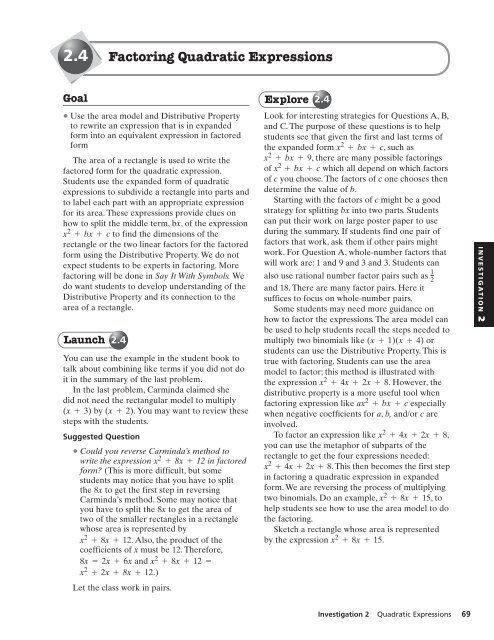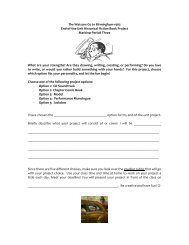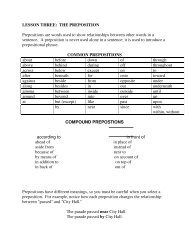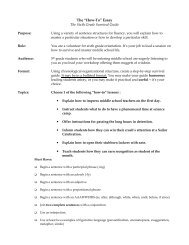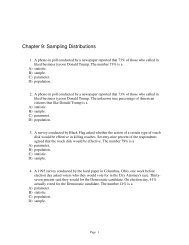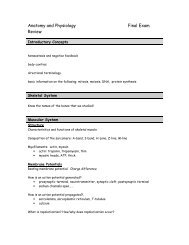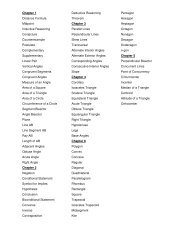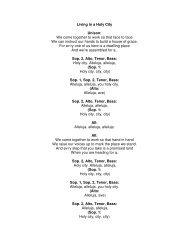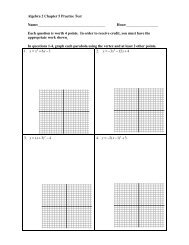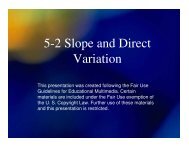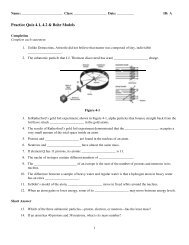2.4 Factoring Quadratic Expressions - Mona Shores Blogs
2.4 Factoring Quadratic Expressions - Mona Shores Blogs
2.4 Factoring Quadratic Expressions - Mona Shores Blogs
You also want an ePaper? Increase the reach of your titles
YUMPU automatically turns print PDFs into web optimized ePapers that Google loves.
<strong>2.4</strong><strong>Factoring</strong> <strong>Quadratic</strong> <strong>Expressions</strong>Goal• Use the area model and Distributive Propertyto rewrite an expression that is in expandedform into an equivalent expression in factoredformThe area of a rectangle is used to write thefactored form for the quadratic expression.Students use the expanded form of quadraticexpressions to subdivide a rectangle into parts andto label each part with an appropriate expressionfor its area. These expressions provide clues onhow to split the middle term, bx, of the expressionx 2 + bx+c to find the dimensions of therectangle or the two linear factors for the factoredform using the Distributive Property. We do notexpect students to be experts in factoring. Morefactoring will be done in Say It With Symbols. Wedo want students to develop understanding of theDistributive Property and its connection to thearea of a rectangle.Launch <strong>2.4</strong>You can use the example in the student book totalk about combining like terms if you did not doit in the summary of the last problem.In the last problem, Carminda claimed shedid not need the rectangular model to multiply(x+3) by (x+2). You may want to review thesesteps with the students.Suggested Question• Could you reverse Carminda’s method towrite the expression x 2 + 8x+12 in factoredform? (This is more difficult, but somestudents may notice that you have to splitthe 8x to get the first step in reversingCarminda’s method. Some may notice thatyou have to split the 8x to get the area oftwo of the smaller rectangles in a rectanglewhose area is represented byx 2 + 8x+12. Also, the product of thecoefficients of x must be 12. Therefore,8x=2x+6x and x 2 + 8x+12=x 2 + 2x+8x+12.)Let the class work in pairs.Explore <strong>2.4</strong>Look for interesting strategies for Questions A, B,and C. The purpose of these questions is to helpstudents see that given the first and last terms ofthe expanded form x 2 + bx+c, such asx 2 + bx+9, there are many possible factoringsof x 2 + bx+c which all depend on which factorsof c you choose. The factors of c one chooses thendetermine the value of b.Starting with the factors of c might be a goodstrategy for splitting bx into two parts. Studentscan put their work on large poster paper to useduring the summary. If students find one pair offactors that work, ask them if other pairs mightwork. For Question A, whole-number factors thatwill work are: 1 and 9 and 3 and 3. Students canalso use rational number factor pairs such asand 18. There are many factor pairs. Here itsuffices to focus on whole-number pairs.Some students may need more guidance onhow to factor the expressions. The area model canbe used to help students recall the steps needed tomultiply two binomials like (x+1)(x+4) orstudents can use the Distributive Property. This istrue with factoring. Students can use the areamodel to factor; this method is illustrated withthe expression x 2 + 4x+2x+8. However, thedistributive property is a more useful tool whenfactoring expression like ax 2 + bx+c especiallywhen negative coefficients for a, b, and/or c areinvolved.To factor an expression like x 2 + 4x+2x+8,you can use the metaphor of subparts of therectangle to get the four expressions needed:x 2 + 4x+2x+8. This then becomes the first stepin factoring a quadratic expression in expandedform. We are reversing the process of multiplyingtwo binomials. Do an example, x 2 + 8x+15, tohelp students see how to use the area model to dothe factoring.Sketch a rectangle whose area is representedby the expression x 2 + 8x+15.12I N V E S T I G AT I O N 2Investigation 2 <strong>Quadratic</strong> <strong>Expressions</strong> 69
Subdivide it into four parts.Suggested Questions• Which part has an area represented by x 2 ?By 15?• How can you split 8x into two pieces so that thepieces represent the remaining two subparts?What clues can you use to split 8x? (The sumof the coefficients of each part must equal8 and their product must equal 15.)• So what two numbers have a sum of 8 and aproduct of 15? (3 and 5. So the areas of thetwo sub parts are 3x and 5x. Students may tryseveral different pairs. )• What are the dimensions of the rectangle?(x+3 and x+5)3xx 23xx155xx 2 15• How can you use the Distributive Property toshow that (x+3)(x+5) is equal tox 2 + 8x+15?Have some groups put their work on largesheets of paper. Make sure you get all of thedifferent strategies that might occur in A–C.In Question D, ask:• Is Alyse correct? How do you know?• What did she do in step 1? Step 2? Step 3?Summarize students’ work in Question Dbefore you have students do Question E.5Summarize <strong>2.4</strong>Call on different students to discuss theirstrategies for factoring expressions. Refer to thelarge posters of the student work. Many will havedrawn diagrams. Have the class ask questions aboutthe work. Be sure to relate the sub areas of therectangle to the parts of the expanded expressionand then relate the factored form to the dimensionsand area of the whole rectangle. Collect severaldifferent rectangles for Question A.Ask the students to show:• A sketch of their rectangle with the area ofits subparts appropriately labeled.• The dimensions of the rectangle.• The two equivalent expressions for the areaof the rectangle.You can tell the students that writing anexpanded form in factored form is calledfactoring.In Questions D and E, ask students to explaintheir method and why it is correct. For example,x 2 + 7x+12=x 2 + 3x+4x+12=x(x+3)+4(x+3)=(x+3)(x+4).Check for UnderstandingDescribe the steps you used to factor theexpanded form of a quadratic.Use the following expressions as examples:x 2 + 7x+8 x 2 - 3x+2 4x 2 + 8x(Students should start by looking for factors ofthe constant term. Then they choose the pairwhose sum is equal to the coefficient of the middleterm or to b in bx. Some may start with findingvarious sums for b and then choosing the twowhose product is equal to the constant term, c.Note: If the coefficient of x 2 is not 1, then findingthe coefficient of x is more complicated.)Suggested Question• How can you check that your answers areequivalent to the original expressions?(Multiply the two factors to see if you get theoriginal expanded form or use a rectangularmodel to check your work or check thegraphs of each equation y=factored formand y=expanded form for each expression.The graphs should be identical.)70 Frogs, Fleas, and Painted Cubes
<strong>2.4</strong><strong>Factoring</strong> <strong>Quadratic</strong> <strong>Expressions</strong>At a GlancePACING 2 daysMathematical Goal• Use the area model and Distributive Property to rewrite an expressionthat is in expanded form into an equivalent expression in factored formLaunchIn the last problem, Carminda claimed she did not need the rectangularmodel to multiply (x+3) by (x+2).You may want to review these steps with the students.• Could you reverse Carminda’s method to write the expressionx 2 + 8x+15 in factored form?Let the class work in pairs.ExploreLook for interesting strategies for Questions A, B, and C. Students couldput their work on large poster paper to use during the summary.If students find one pair of factors that works, ask them if other factorpairs might work. Some students may need more guidance on how to factorthe expressions.We are reversing the process of multiplying two binomials.Do an example, x 2 + 8x+15, to help students see how to use the areamodel to do the factoring.Sketch a rectangle whose area is represented by the expressionx 2 + 8x+15. Subdivide it into four parts.• Which part has an area represented by x 2 ? By 15?• How can you split 8x into two pieces so that the pieces represent theremaining two subparts? What clues can you use to split 8x? What twonumbers have a sum of 8 and a product of 15? What are the dimensionsof the rectangle?• How can you use the Distributive Property to show that (x+3)(x+5)is equal to x 2 + 8x+15?Have some groups put their work on large sheets of paper. Make sureyou get all of the different strategies that might occur in Questions A, B,and C. In Question D, ask:• Is Alyse correct? How do you know?• What did she do in step 1? Step 2? Step 3?Summarize Question D before you have students do Question E.Materials• Poster Paper(optional)Investigation 2 <strong>Quadratic</strong> <strong>Expressions</strong> 71
SummarizeCall on different students to discuss their strategies for factoringexpressions. Refer to the large posters of the student work. Relate thesub areas of the rectangle to the parts of the expanded expression andthen relate the factored form to the dimensions and area of the wholerectangle.In Questions D and E, ask students to explain their method and whyit is correct. For example, x 2 + 7x+12=x 2 + 3x+4x+12=x(x+3)+4(x+3)=(x+3)(x+4).Describe the steps you used to factor the expanded form of aquadratic.• How can you check that your answers are equivalent to the originalexpressions?Materials• Student notebooksACE Assignment Guidefor Problem <strong>2.4</strong>Core 29–39Other Connections 56, Extensions 62–64;unassigned choices from previous problemsAdapted For suggestions about adapting ACEexercises, see the CMP Special Needs Handbook.Connecting to Prior Units 56: Moving StraightAheadAnswers to Problem <strong>2.4</strong>A. 1. Possible drawing:3x3x3xx 2 9x3Since the lengths of the two segmentsmarked with question marks seem to be thesame length, students may argue that 3 and3 are the only factors of 9 that will work,while others will claim that 1 and 9 arepossibilities as well. Either case isacceptable.2. Possible answers:Factored form: (x+3)(x+3);Expanded: x 2 + 3x+3x + 9 orx 2 + 6x+9;Factored form: (x+1)(x+9);Expanded: x 2 + x+9x+9 orx 2 + 10x+9.1xx x 2 9xxNote: There are infinitely more factor1pairs that will work for 9 such as and 1821or and 36. For this problem we can focus4on the whole-number factors.B. 1. If b=9, then x 2 + 9x+8 in factoredform is (x+1)(x+8).If b=6, then x 2 + 6x+8 in factoredform is (x+2)(x+4).If b=-9, then x 2 - 9x+8 in factoredform is (x-1)(x-8).9972 Frogs, Fleas, and Painted Cubes
If b=-6, then x 2 - 6x+8 in factoredform is (x-2)(x-4).Note: Not every b value that students pickwill result in a quadratic expression that isfactorable at this time by students. Forexample a b value of 10 gives an expressionof x 2 + 10x+8. This expression cannot befactored by students unless they know thequadratic formula which they may notlearn until high school.In this problem, we want students to realizethat they are looking at the factor pairs of 8and finding a pair whose sum is the valuefor b that will make x 2 + bx+8 anexpression that can be factored. Restrictingthe factor pairs of 8 to integers, we have(1 and 8), (-1 and -8), (-2 and -4), and(2 and 4). So the values for b are 9,-9,-6 and 6, respectively, as illustrated above.For the case where b=6, a possible studentexplanation may include the use of an areamodel such as the one shown below:The factor pair consisting of 2 and 4 yieldsa b value of 6 and the factored form of(x+2)(x+4) for x 2 + 6x+8.2. Students will probably find that not all oftheir classmates found the same expressions.However the expressions that students willhave will be either (x+2)(x+4),(x+1)(x+8), (x-1)(x-8) or(x-2)(x-4).C. 1. r=44x4x2. r=3, s=8 (or r=8, s=3)2xx 2 83. r=1 and s=24 or r=24 and s=14. A common strategy is to compare the “c”term of the x 2 + bx+c form to thex2constant terms in the factors; r and s mustbe factors of c. Meanwhile, the sum of r ands must make b.D. Yes; Students can make an area model tocheck that x 2 + 10x+16=(x+2)(x+8).They may also reason that Alyse applied theDistributive Property. In step 1, she separated10x into 2x+8x and in step 2 she used theDistributive Property to rewrite x 2 + 2x asx(x+2) and 8x+16 as 8(x+2). In step 3,she used the Distributive Property to see that(x+2) is multiplied by both x and 8 so shecan factor the (x+2) term out and multiplyit by the remaining (x+8).E. 1. Using the Distributive Property:x 2 + 5x+2x+10=x(x+5)+2(x+5)=(x+5)(x+2).Note: Students may also write this as(x+2)(x+5) which is equivalent becauseof the Commutative Property ofMultiplication. In the answers forQuestion E, parts (1) and (4) the commonfactor has been pulled out in front since itseems the most natural. For part (1), thefactor of x+5 was pulled out in front toobtain (x+5)(x+2).2. Using the Distributive Property:x 2 + 11x+10=x 2 + 10x+x+ 10=x(x+10)+1(x+10)=(x+10)(x+1).3. Using the Distributive Property:x 2 + 3x-10=x 2 + 5x-2x-10=x(x+5)-2(x+5)=(x+5)(x-2).4. Using the Distributive Property:x 2 + 16x+15=x 2 + 15x+1x+15=x(x+15)+1(x+15)=(x+15)(x+1).5. Using the Distributive Property:x 2 - 8x+15=x 2 - 3x-5x+15=x(x-3)-5(x-3)=(x-5)(x-3).6. Using the Distributive Property:x 2 - 12x + 36 = x 2 - 6x+-6x + 36 =x(x-6)+-6(x-6)=(x-6)(x-6).Note: Students may need help seeing that-5 is a factor of -5x and 15 in part (5) orthat -2 is a factor of -2x and -10 inpart (3). <strong>Factoring</strong> out a negative quantity isrepresented somewhat differently in thepart (6) solution.I N V E S T I G AT I O N 2Investigation 2 <strong>Quadratic</strong> <strong>Expressions</strong> 73
74 Frogs, Fleas, and Painted Cubes


